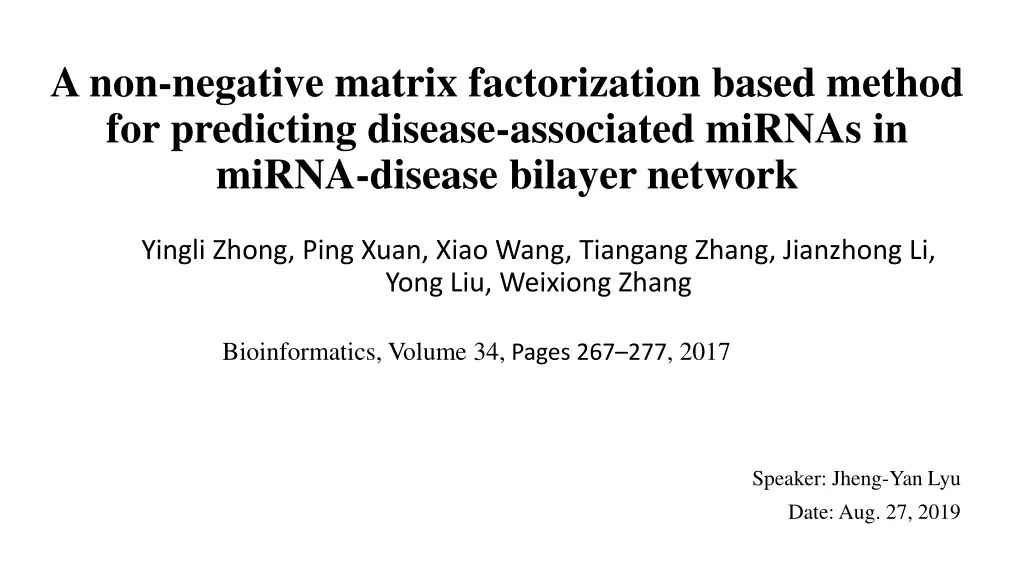
Disease-associated miRNA Prediction Using Matrix Factorization
Explore a novel non-negative matrix factorization method for predicting disease-associated miRNAs in a bi-layer network. The approach integrates miRNA functional similarity, disease similarity, and miRNA-disease associations effectively for accurate predictions across various diseases.
Download Presentation

Please find below an Image/Link to download the presentation.
The content on the website is provided AS IS for your information and personal use only. It may not be sold, licensed, or shared on other websites without obtaining consent from the author. If you encounter any issues during the download, it is possible that the publisher has removed the file from their server.
You are allowed to download the files provided on this website for personal or commercial use, subject to the condition that they are used lawfully. All files are the property of their respective owners.
The content on the website is provided AS IS for your information and personal use only. It may not be sold, licensed, or shared on other websites without obtaining consent from the author.
E N D
Presentation Transcript
A non-negative matrix factorization based method for predicting disease-associated miRNAs in miRNA-disease bilayer network Yingli Zhong, Ping Xuan, Xiao Wang, Tiangang Zhang, Jianzhong Li, Yong Liu, Weixiong Zhang Bioinformatics, Volume 34, Pages 267 277, 2017 Speaker: Jheng-Yan Lyu Date: Aug. 27, 2019
Abstract (1/2) Motivation: Identification of disease-associated miRNAs (disease miRNAs) is critical for understanding disease etiologyandpathogenesis.SincemiRNAsexerttheirfunctionsbyregulatingtheexpressionoftheirtargetmRNAs, severalmethodsbasedonthetargetgeneswereproposedtopredictdiseasemiRNAcandidates.Theyachieved onlylimitedsuccessastheyallsufferedfromthehighfalse-positiverateoftargetpredictionresults.Alternatively, other prediction methods were based on the observation that miRNAs with similar functions tend to be associated with similar diseases and vice versa. The methods exploited the information about miRNAs and diseases, including the functional similarities between miRNAs, the similarities between diseases, and the associations between miRNAs and diseases. However, how to integrate the multiple kinds of information completelyandconsider thebiological characteristicof disease miRNAsisachallengingproblem. Results: We constructed a bilayer network to represent the complex relationships among miRNAs, among diseases and betweenmiRNAsanddiseases.Weproposedanon-negativematrixfactorizationbasedmethodtorank,soasto predict,thediseasemiRNAcandidates. 2
Abstract (2/2) The method integrated the miRNA functional similarity, the disease similarity and the miRNA-disease associations seamlessly, which exploited the complex relationships within the bilayer network and the consensus relationship betweenmultiplekindsofinformation.Consideringthecorrelationbetweenthecandidatesrelatedtovariousdiseases, itpredictedtheirrespectivecandidatesforallthediseasessimultaneously.Inaddition,thesparsenesscharacteristicof diseasemiRNAswasintroducedtogeneratemorereliablepredictionmodelthatexcludesthosenoisycandidates.The resultson15commondiseasesshowedasuperiorperformanceofthenewmethodfornotonlywell-characterized diseasesbutalsonewones.Adetailedcasestudyonbreastneoplasms,colorectalneoplasms,lungneoplasmsand32 otherdiseasesdemonstratedtheabilityofthemethodfordiscoveringpotentialdiseasemiRNAs. 3
Disease similarity measurement The DV value of breast neoplasms is 1.0 (breast neoplasms) + 0.5 (breast diseases) + 0.5 (neoplasms by site) + 0.5 0.5 (neoplasms) + 0.5 0.5 (skin diseases) + 0.5 0.5 0.5 (skin and connective tissue diseases) = 2.6250
MiRNA similarity measurement MiRNA ma is associated with diseases d1, d2, d3, d4 and d8 MiRNA mb is associated with d1, d2, d5 and d8. DTa={d1,d2,d3,d4,d8} DTb={d1,d2,d5,d8} 6
Construction of miRNA-disease bilayer network Construction of MiRNet. 7
Construction of miRNA-disease bilayer network Construction of DisNet. 8
Construction of miRNA-disease bilayer network Edges between MiRNet and DisNet. 9
Construction of miRNA-disease bilayer network miRNA-disease bilayer network 10
Modelling the edges between MiRNet and DisNet || ||F is the Frobenius norm of a matrix and is the Hadamard product.
Algorithm for predicting the miRNA candidates associated with diseases
Results The area under the ROC curve (AUC) is used to measure the global performance of a prediction method.
Results The average accuracies across all the tested diseases at different top k Prediction results of DMPred and the other methods for the diseases whose respective associations were removed
